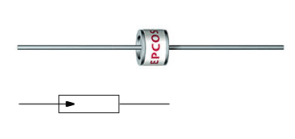spark gap
A spark gap is a discharge gap via which overvoltages are discharged. Such a surge arrester consists of two metallic electrodes, which are placed at a certain distance from each other.
The electrodes of a spark gap can be located in a glass body and surrounded by air or a gas. Spark gaps are designed for low voltage, medium voltage and high voltage and are used in devices, power supplies and systems, but also in substations or in high-voltage transmission.
They are designed in such a way that above a certain voltage, the distance between the electrodes, which is very high-resistance in normal operation, becomes ionized and thus low-resistance, and a brief current flow occurs from one electrode to the other. The discharge between the electrodes is manifested by a spark. The decisive factor for the flashover voltage is the distance between the electrodes. At low voltages, the distance between the electrodes is less than one millimeter; at high voltages, it can be more than one meter. At atmospheric pressure, the flashover voltage is about 3,000 V/mm.

